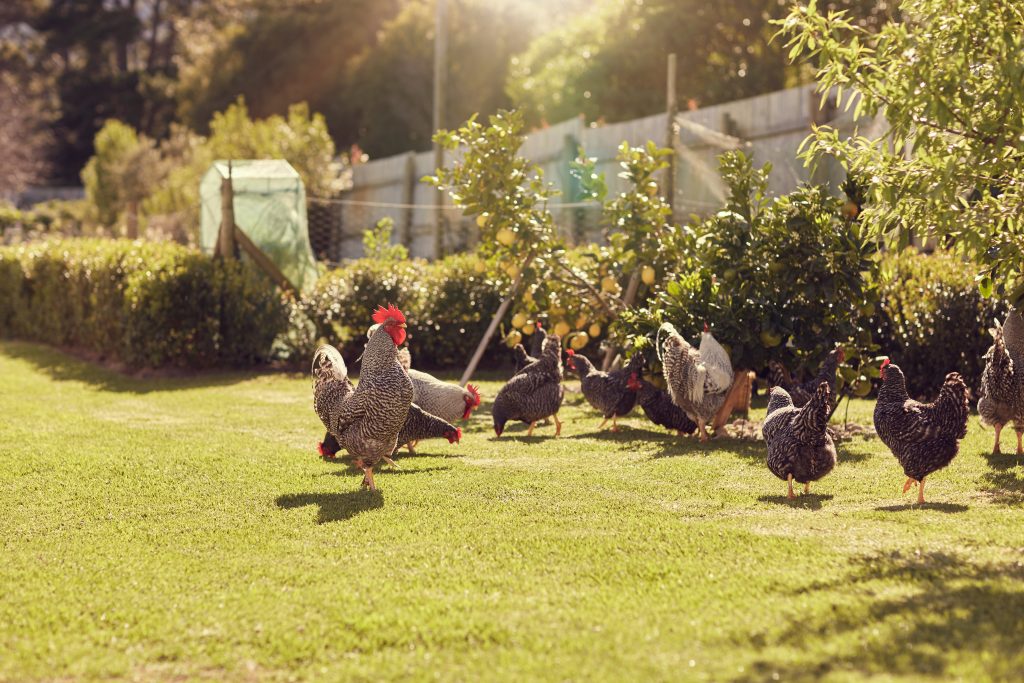Millions of Americans proudly harvest tomatoes, squash, beans, lettuce and a host of other vegetables from their backyard garden. Delicious, fresh, clean homegrown vegetables are far superior to counterparts purchased in the supermarket.
The satisfaction that vegetable gardening creates extends to backyard chickens. No market egg is ever as delicious as the one laid in a backyard coop. Fortunately, few activities are as compatible as backyard chickens and gardening. Chickens can help perform some of the most dreary gardening chores while converting pesky insects and weeds into eggs.
Successfully meshing chickens with gardens can be tricky. They love dining on lettuce and other leafy crops yet shun others. Knowing how to manage chickens to optimize the garden is important to success. Here are a few tips:
Using Chickens to Prepare a New Garden Space
Often a homeowner will create a new garden in existing lawn sod. Ridding the area of thick sod is a chore requiring a herbicide application, backbreaking work digging out the sod or a combination of the two. Chickens will happily do much of the work. They love dining on lawn plants and readily gobble up nearly any protein-rich insect they can find with gusto.
Using chickens to prepare a garden spot takes some time and portable fencing. Many types of lightweight portable fences are on the market and are easy to use. Often installation doesn’t even require hammering in fence posts. The fence should be at least three feet tall to contain heavy breed chickens. Locate the future garden spot, erect the fence around it, and turn in the chickens. In a few weeks, they will transform the sod into bare ground. While foraging on plants and insects they’ll leave plenty of nutrient-rich droppings to nurture future plants. This method works best if the new garden spot is located adjacent to or near the permanent chicken run. This makes it simple to extend a temporary fence around the new garden spot, giving the chickens access but letting them return to the coop for water, feed, nests, and their nighttime roost.
When the chickens have the garden area ground mostly bare, the hens can be returned to their permanent run, the temporary fence removed and a little pitchfork and rake work will make the new garden ready for its first seeds.

Using Chickens for Fall Garden Cleanup
When fall’s last tomato and pumpkin are brought into the kitchen, most gardens are a tangle of dead vines and withered vegetable plants. An important but unexciting chore is cleaning up the garden in preparation for next spring’s planting. Chickens can help. Ring the garden with the temporary fence and turn in the hens. They will feast on insects that potentially would be next summer’s vegetable pests. Hens will dust bathe in the soil, turning and loosening it, and they’ll eat many remaining weeds. Give the girls a week or two in the fall garden before returning them to the permanent run. Then simply remove any remaining old dried vines and stems, rake the loosened soil, and the garden is nearly ready for next spring’s planting.
Letting Chickens Forage in the Garden
Sometimes chickens can be allowed to forage in the garden while crops are growing. It works but requires basic chicken knowledge and fencing. Chickens love some garden crops and will readily devour lettuce, chard, radish tops, and many other tasty greens. Giving them access to these crops guarantees that salads won’t be on the human menu. Hens also casually peck at green bean plants and unripe winter squash, pumpkins and melons. This ruins the produce. Although chickens rarely damage tomato plants or their unripe fruit the moment tomatoes turn red, chickens will devour them. Many crops and chickens are simply not compatible. That doesn’t mean that chickens can never be allowed into a garden. They rarely bother tall plants or hard stems, so once okra gets a few feet tall chickens can forage for insects beneath the plants. Hens are totally compatible with fruit trees. They will happily eat insects, grass, and dropped spoiled fruit but generally won’t bother immature fruit up on the branches.
It is sometimes possible to fence off tender crops that chickens love to eat. For example, a lettuce bed can be ringed with light wire mesh that excludes birds. Fencing also fends off hungry cottontail rabbits. Ringing raised beds with lightweight wire mesh that can be lifted to enable the gardener to weed or harvest will keep hens away from tender crops while allowing them to forage in pathways.
Garden crops thrive on the nutrients in chicken droppings. Chicken poop is concentrated so a small amount goes a long way when fertilizing a garden. The best way to use droppings is to compost them with litter cleaned out from the coop. In the composting process, high nutrient chicken droppings help microbes decompose wood chips and straw often used for coop bedding. Most gardeners would rather add compost to the garden than raw manure.
When done thoughtfully, chickens and gardens complement each other. Watching a flock of hens gleefully devour insects and loosen the soil is a pleasant sight for any gardener.
We’re going live on Facebook with our expert backyard chicken grower Rich Patterson of Winding Pathways on June 15th! Do you have questions about gardening and chickens? Join us and give us your questions ahead of time for Rich to answer here.